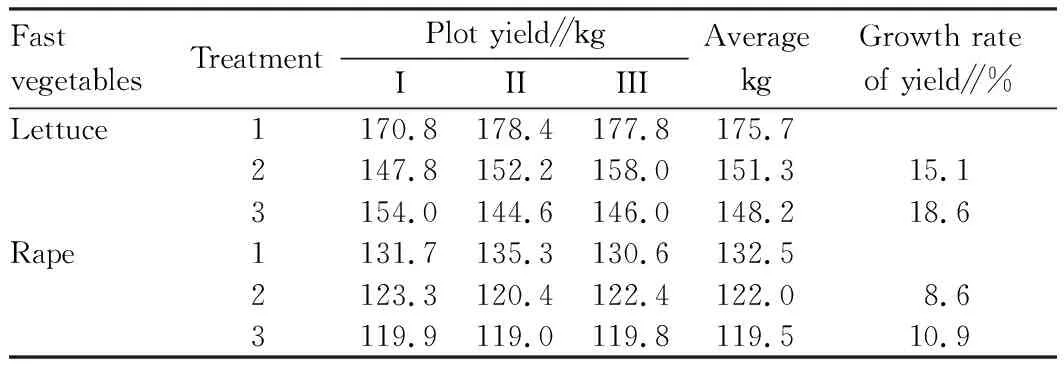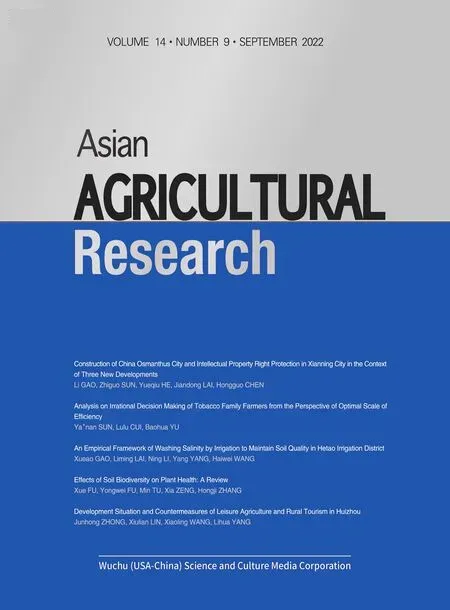Evaluation of Application Effect of Silicon-containing Water-soluble Fertilizer on Fast Vegetables
2022-11-08GuanghuiFENGDongwenSUNHaijuanZHANGBoGENGLiyuanLILihuaDUTongSONG
Guanghui FENG, Dongwen SUN, Haijuan ZHANG, Bo GENG, Liyuan LI, Lihua DU, Tong SONG
Zibo Digital Agriculture Rural Development Center, Zibo 255000, China
Abstract [Objectives] The study aims to verify the application effect of silicon-containing water-soluble fertilizer on fast vegetables. [Methods] Two vegetable crops, rape and lettuce, were studied, and three treatments were set up, including treatment 1 (conventional fertilization+foliar spraying of silicon-containing water-soluble fertilizer, treatment 2 (conventional fertilization+foliar spraying of the same amount of clear water), and treatment 3 (conventional fertilization). [Results] The yield of lettuce and rape in treatment 1 increased by 15.1% and 8.6%, respectively; compared with treatment 3, the yield of lettuce and rape rose by 18.6% and 10.9%, respectively. Variance analysis shows that the F values of lettuce and rape were 20.938 and 35.372, respectively, and the differences among various treatments were extremely significant. [Conclusions] The application of silicon-containing water-soluble fertilizer on lettuce and rape significantly increased their yield.
Key words Silicon-containing water-soluble fertilizer, Fast vegetables, Fertilizer efficiency
1 Introduction
Silicon is an essential nutrient element for the growth and development of crops, and is considered by the international soil community to be the fourth plant nutrient element after nitrogen, phosphorus and potassium[1-3]. Silicon fertilizer, which is a new type of fertilizer developed in recent years, has the functions of increasing nutrients, improving soil, preventing diseases and insects and reducing the adsorption of heavy metals by crops[4]. According to relevant reports, the application of silicon-containing water-soluble fertilizers has a significant promoting effect on rice and wheat. After being applied to maize, it can increase the leaf area index of rice to a certain extent, enhance photosynthetic capacity, improve ear traits, slightly improve disease resistance[5], make maize thicker, increase the number of aerial roots, enhance stress resistance and lodging resistance[6], and increase the number of ears per hectare, the number of grains per ear, thousand grain weight and yield, and the effect of increasing yield was significant[1]. Besides, it can promote the early entry of wheat into the growth period, enhance its resistance to pests and diseases, and increase the effective number of ears and thousand grain weight[7]. At present, there are few studies on the application of silicon-containing water-soluble fertilizers on vegetables. In order to verify the spraying effect of silicon-containing water-soluble fertilizers on facility fast vegetables, a fertilizer efficiency test on facility lettuce and rape was carried out in 2021 to provide a scientific basis for vegetable farmers.
2 Materials and methods
2.1 General situation of the experimental fieldThe experimental field is located in the vegetable base of Hejia Village, Beijiao Town, Zhoucun District, Zibo City. Zhoucun District (36°39′-36°54′ N, 117°41′-117°58′ E) is located in the warm temperate zone, with four distinct seasons, and annual average precipitation is 761.2 mm.
2.2 Experimental materialsThere were 2 varieties of fast vegetables participating in the test, namely lettuce (Italian lettuce) and rape (improved Jinpin 208). The fertilizer used was a silicon-containing water-soluble fertilizer, and was provided by Shandong Leyouyou Fertilizer Technology Co., Ltd. The test was from October 2021 to December 2021.
2.3 Experimental designA total of 3 treatments were set up in the experiment, namely treatment 1 (conventional fertilization+foliar spraying of silicon-containing water-soluble fertilizer, treatment 2 (conventional fertilization+foliar spraying of the same amount of clear water), and treatment 3 (conventional fertilization). The area of each plot was 20 m2, and the plots were randomly arranged in blocks, with three repetitions. The tested lettuce and rape were planted on October 21. In treatment 1, based on conventional fertilization, lettuce and rape were sprayed with 250 times of silicon-containing water-soluble fertilizer respectively on November 18, November 29, and December 6; in treatment 2, they were sprayed with equal amount of clean water in the same periods; in treatment 3, conventional fertilization was conducted.
2.4 Investigation content and methodAbout a week after lettuce and rape were sprayed with silicon-containing water-soluble fertilizer (November 18, November 29, and December 6), their safety in each treatment was investigated, and whether the color of the fast vegetables was normal and the leaf characteristics changed was observed. After the 2ndand 3rdspraying, the growth of the fast vegetables in each treatment was observed and compared. The plot yield of lettuce and rap was recorded and converted into mu yield for comparative analysis to calculate the growth rate of yield.
2.5 Data analysisIn Excel 2003, the function was used to carry out variance analysis and multiple comparison of the field experiment, and the analysis results were analyzed.
3 Results and analysis
3.1 Effects on agronomic characters of the fast vegetables
Field observation was conducted 7 d after silicon-containing water-soluble fertilizer was sprayed. Compared with treatment 2 (spraying the same amount of clear water+conventional fertilization) and treatment 3 (conventional fertilization), lettuce and rape were lush, with dark green leaves, large and thick leaves in treatment 1 (spraying silicon-containing water-soluble fertilizer+conventional fertilization) (Table 1).

Table 1 Effects of different treatments on the agronomic characters of the fast vegetables
3.2 Impact on the safety of the fast vegetablesSeven days after silicon-containing water-soluble fertilizer was sprayed, the color of the leaves of lettuce and rape in treatment 1 was darker green than that of treatment 2 and treatment 3. There was no difference in the shape of their leaves in each treatment, and there was no problem of fertilizer damage. The growth period of lettuce and rape was investigated, and it was found that their maturity period was basically the same. In general, the dosage of the applied silicon-containing water-soluble fertilizer was suitable and safe for the fast vegetables.
3.3 Impact on the yield of the fast vegetablesIt can be seen from Table 2 that the plot yield of lettuce in treatment 1 was the highest, up to 175.7 kg, increasing by 15.1% and 18.6% compared with treatments 2 and 3, respectively; the plot yield of rape in treatment 1 was also the highest, reaching 132.5 kg, increasing by 8.6% and 10.9% compared with treatments 2 and 3, respectively.

Table 2 Plot yield of the fast vegetables
Variance analysis was performed on the experimental data of lettuce and rape. The results show that theFvalue of lettuce was 20.938>F0.01=18.0, and theFvalue of rape was 35.372>F0.01=18.0, so the differences were extremely significant (Table 3).
The least significant range method (LSR-SSR) was used to conduct multiple comparisons (Table 4). For lettuce and rape, there was an extremely significant difference between treatment 1 and treatment 2 or treatment 3; there was no significant difference between treatment 2 and treatment 3. It shows that the application of silicon-containing water-soluble fertilizer on lettuce and rape had a significant effect of increasing yield.

Table 4 Yield of the fast vegetables and multiple comparisons (LSR-SSR least significant range method)
3.4 Impact on the economic benefits of the fast vegetablesThe fast vegetables were sprayed with silicon-containing water-soluble fertilizer 3 times. The usage of the fertilizer was 6 750 mL/ha, and the price was 30 yuan; the manpower was 7.5, and the cost was 900 yuan. If the price of the fast vegetables was 2.0 yuan/kg, the net income of lettuce increased by 22 563 yuan/ha, and the input-output ratio was 1∶50.1; compared with conventional fertilization, the yield increased by 18.6%, and the net income rose by 26 163 yuan/ha, with the input-output ratio of 1∶19.4 (Table 5). The net income of rape increased by 10 065 yuan/ha, and the input-output ratio was 1∶22.4; compared with conventional fertilization, the yield increased by 10.9%, and the net income rose by 11 634 yuan/ha, with the input-output ratio of 1∶8.6.

Table 5 Analysis of economic benefits
4 Discussion
Through the experiments, it was found that after the fast vegetables were sprayed with silicon-containing water-soluble fertilizer, their agronomic properties were significantly improved, and the growth was strong; the leaves were dark green, large and thick. It shows that silicon-containing water-soluble fertilizer can not only supplement a large number of elements needed by fast vegetables, but also can promote the photosynthesis of plants, promote the growth of leaves, and play a pivotal role in the function of leaves. The characteristics of the fast vegetable leaves did not change after the application of the fertilizer, indicating that the dosage of silicon-containing water-soluble fertilizer was appropriate, and the application on the fast vegetables was safe and reasonable.
From the yield data of lettuce and rape, it was found that the average yield of lettuce in treatment 1 (spraying silicon-containing water-soluble fertilizer) increased by 15.1% and 18.6% compared with treatments 2 and 3; after deducting fertilizer and labor costs, the economic benefit increased by 27 513 yuan/ha. The average yield of rape in treatment 1 rose by 8.6% and 10.9% higher than that of treatments 2 and 3. After fertilizer and labor employment were deducted, the economic benefit increased by 12 984 yuan/ha. Variance analysis on the experimental data of the fast vegetables show that theFvalues of lettuce and rape were 20.938 and 35.372, both greater than 18.0, indicating that the differences among the treatments were extremely significant; from multiple comparisons performed by using the least significant range method (LSR-SSR), the differences between various treatments were found to be extremely significant. It can be seen that silicon-containing water-soluble fertilizer played an important role in increasing the accumulation of organic matter in the fast vegetables, enhancing crop yield and economic benefits. It is recommended to further expand the demonstration and promotion of silicon-containing water-soluble fertilizer, and accelerate the application of silicon-containing water-soluble fertilizer on vegetables.
杂志排行
Asian Agricultural Research的其它文章
- Preliminary Study on the Training Mode of Chinese Pharmacy Professionals Based on the National Standard of Teaching Quality
- Study on Case Library Construction of Inspection and Quarantine of Aquatic Animal
- Teaching Reform and Practice of Traditional Chinese Medicine Course Based on National Standard and Ideological and Political Theories Teaching in All Courses
- Exploration of Development Status and Trend of Three Elements of Rural Areas in the New Era to Protect Achievements in Poverty Alleviation
- Development Situation and Countermeasures of Leisure Agriculture and Rural Tourism in Huizhou
- Development Prospects of Osmanthus fragrans Mixed Wine Based on Liquor and Spirits
